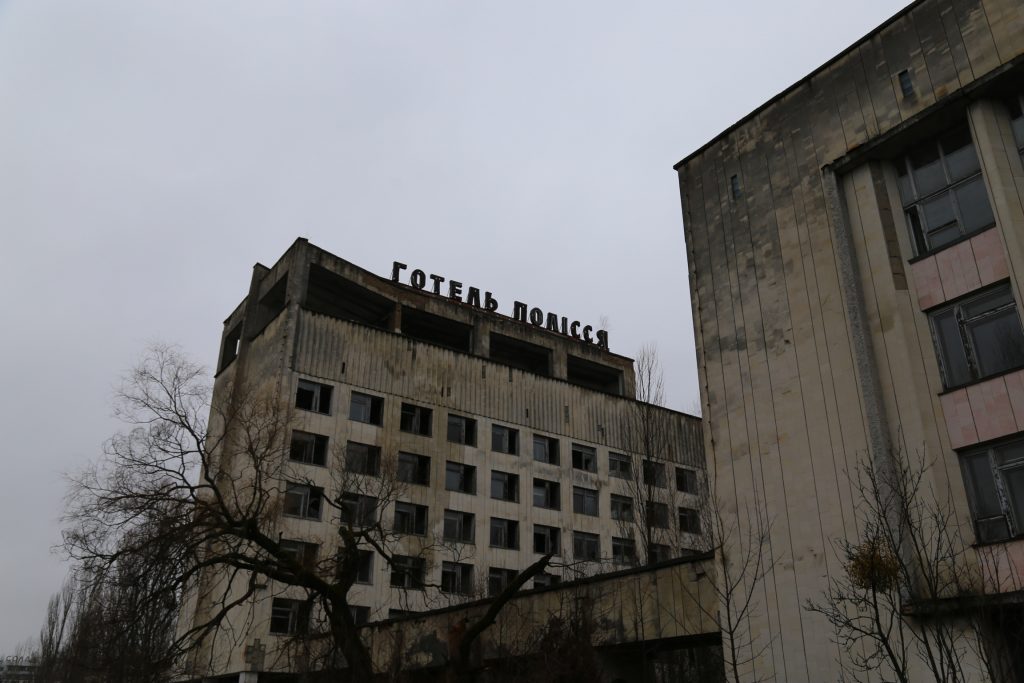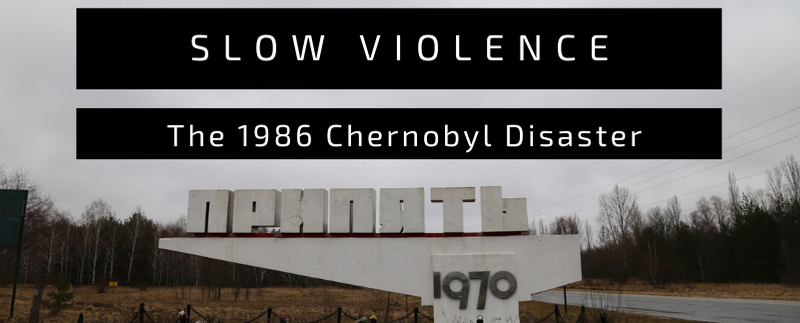Slow Violence and the 1986 Chernobyl Disaster
Slow Violence and the 1986 Chernobyl Disaster
by Lisa May
On April 26, 1986, the fourth reactor of the Chernobyl nuclear power plant, near the town of Pripyat in the former Ukrainian SSR, exploded. Estimates show that 50 million curies of radiation were released into the atmosphere – “the equivalent of 500 Hiroshima bombs.”[1] Some 57,915 sq. miles of modern day Belarus, Russia, and Ukraine alone are considered to be contaminated.[2] Radiation spread over vast territories of the Northern Hemisphere, and continues to affect lives of thousands of people globally. The catastrophe has become synonymous with human suffering and introduced new concepts into the lives of Ukrainians, Russians, and Belarusians such as “children of Chernobyl,” “Chernobyl heart,” “Chernobyl dust,” and “Chernobyl collar” (referring to thyroid disease).[3]
In December 2010, the Ukrainian government opened the area around the Chernobyl nuclear plant to visitors. While generating tourism revenue for the state, this commercialization of the exclusion zone completely ignores the horrors that people survived and the post-accident reality that many Ukrainians experience and struggle with to this day. For this reason, I argue that the Chernobyl disaster fits Rob Nixon’s definition of slow violence, which is “a violence that occurs gradually and out of sight, a violence of delayed destruction that is dispersed across time and space, an attritional violence that is typically not viewed as violence at all.”[4] Nixon highlights “the temporal dispersion of slow violence,” which is incremental, and leads to consequences that are not immediately tangible.[5] For these reasons, the violence often lacks visibility, especially today, when newsworthiness is measured by the death toll, the number of injured, the number of buildings destroyed, etc. Nixon writes that “chemical and radiological violence, for example, is driven inward, somatized into cellular dramas of mutation that – particularly in the bodies of the poor – remain largely unobserved, undiagnosed, and untreated.”[6]
At a first glance, the Chernobyl disaster does not neatly fit Nixon’s definition of slow violence. It was an explosion that received plenty of visibility and media coverage at the time. However, the health and environmental impacts that the meltdown continue to have on people living in the area, gradually became forgotten or neglected, even now as tourists visit Chernobyl, and others start relocating closer to the exclusion zone. My research sheds light on the environmental and public health consequences of the Chernobyl catastrophe in Ukraine and provides recommendations for the Ukrainian government to address the diversity of challenges facing Chernobyl survivors.
Public Health Effects
Since the 1986 explosion, several studies identified and explored the impacts of the Chernobyl disaster on public health. Experts agree that more research to understand the full impact of the catastrophe will need to be conducted for many years to come. The Chernobyl catastrophe introduced a multitude of stressors. During the evacuation, families sometimes were separated, and pregnant women were often told to have abortions.[7] The evacuees were not welcomed by members of host communities as they were heavily stigmatized due to their exposure to radiation.[8] According to studies on mental health effects of the Chernobyl catastrophe, there has been a two-fold increase in post-traumatic stress and anxiety disorders among the liquidators (disaster clean-up workers) and adults living in contaminated areas.[9] Additionally, suicide rates among the disaster clean-up workers are higher than those in the rest of the population.[10]
Another study demonstrates that when areas of Ukraine (heavily contaminated by radiation) were compared to those less contaminated but similar in ethnography, economy, demography, and environment, there was “increased morbidity in the more contaminated territories, increased numbers of weak newborns, and increased impairment and disability.”[11]
Incidences of thyroid cancer in Ukrainian children increased ten-fold since the accident.[12] Individuals who were younger than 4 years old or in utero at the time of the meltdown were at the highest risk, “accounting for 42% of the cases.”[13] Diseases affecting the endocrine system became the main cause of disability among children in highly contaminated territories.[14] Studies also show that Chernobyl radiation suppressed the immune system, which led to an increase in the frequency of acute and chronic diseases as well as infections. Occurrences of chronic tonsillitis, hypertrophy of the adenoid glands and tonsils, and an increased occurrence of lymphadenopathies became typical after the 1986 disaster, especially in children.[15]
Environmental Impacts
When it comes to environmental consequences of the Chernobyl catastrophe, it had major adverse effects on ecosystems in the Northern Hemisphere, and in Ukraine, Belarus, and Russia in particular. In the exclusion zone, researchers documented “increased mortality of coniferous plants, soil invertebrates and mammals, as well as reproductive dysfunction in plants and animals.”[16] Furthermore, in the years following the accident, genetic anomalies in plants and animals attributable to radiation were registered.[17] Radioactive contamination has reduced the speed of biomass decomposition, leading to the accumulation of dead wood and slow growth of plants.[18] This heightens the possibility of forest fires releasing radionuclides contained in trees.
Many Belarussian, Ukrainian, Russian, Latvian, and Lithuanian rivers were shown to be contaminated after the catastrophe. Contamination levels have remained relatively high for years, “because some radionuclides were transferred from contaminated catchment soils to water bodies.”[19] The most contaminated lakes are the so-called “closed” lakes – those with limited inflowing and outflowing streams.[20] Concentrations of radiocesium in fish in some of these lakes will remain high for a significant time into the future. Concentrations of radioactive contamination are significantly lower in sea water than in freshwater due to the large distance between the Black Sea and the Sea of Azov from Chernobyl.[21]



Recent Tourism Developments
After the 2019 release of the HBO miniseries “Chernobyl”, there has been a significant uptick in tourists visiting the exclusion zone. On one hand, this kind of tourism is a source of much-needed income for the country (though tours are usually given by guides from Kyiv and locals do not directly benefit from the tourist activity). On the other hand, the place where such a terrible tragedy happened has basically turned into an amusement park with tourists from all around the world taking happy selfies and even doing photoshoots. How does this help honor the memory of those whose lives were ruined by the 1986 disaster? How does this help those who became sick in the aftermath of the catastrophe? I believe that the Ukrainian government should have considered these concerns and addressed many other questions prior to opening up the exclusion zone to tourism.
Recommendations
While closing the area to tourism would be the most logical step in respecting the memory of those who died or became terminally ill in the aftermath of the accident, this is unlikely. Therefore, I suggest some alternative actions that are more politically feasible and have the greatest likelihood of ameliorating the outlined issues and meaningfully supporting those most affected by the accident.
- No photos or videos should be allowed during the tour. This way, the visitors touring the exclusion zone will be paying better attention to the tour instead of trying to take a photo for their Facebook or Instagram page. Additionally, banning photos will deter people who are not actually interested in the history of the area from taking the tour.
- Typically the tour company picks up tourists in Kyiv and drives them to the exclusion zone. During the trip, the guide should show tourists documentaries about the 1986 disaster, featuring the stories of the liquidators and evacuees so that the tourists could understand the true cost of the nuclear fallout.
- The companies that are allowed to give tours in the exclusion zone should allocate a set percentage of the profits from this kind of tourism either to scientific research on health and environmental consequences of the Chernobyl disaster or to help the victims of the disaster in other ways. As of January 2018, 1.8 million people in Ukraine, including 377,589 children, held the status of victims of the Chernobyl catastrophe.[22]
This is adapted from a larger study. Click here to read the full paper.

Lisa May is a Master of Arts in Law and Diplomacy Candidate (2020) at The Fletcher School studying Human Security and International Information and Communication. Her regional focus is Russia and Eastern Europe. Before coming to The Fletcher School, she interned at the U.S.-Ukraine Foundation and worked as a social media and marketing manager for small and medium businesses. Lisa received her B.A. in Global Affairs with a concentration in Global Governance from George Mason University. Additionally, she studied translation (Spanish and English) at Taras Shevchenko National University of Kyiv. She spent the summer of 2019 interning for Center for Civil Liberties, a human rights organization based in Kyiv, Ukraine. Lisa’s research interests include U.S.-Ukraine relations, U.S.-Russia relations, human rights in post-Soviet states, as well as the role of the media in democracies.
Footnotes:
[1] Serhii Plokhy, “The Chernobyl Cover-Up: How Officials Botched Evacuating an Irradiated City,” History, updated May 10, 2019, https://www.history.com/news/chernobyl-disaster-coverup.
[2] Richard Gray, “The True Toll of the Chernobyl Disaster,” BBC Future.
[3] Alexey Nesterenko, Vassily Nesterenko, and Alexey Yablokov, “Introduction: The Difficult Truth About Chernobyl,” in Chernobyl: Consequences of the Catastrophe for People and the Environment, (Annals of the New York Academy of Sciences, 2009), 1, https://nyaspubs-onlinelibrary-wiley-com.ezproxy.library.tufts.edu/doi/epdf/10.1111/j.1749-6632.2009.04819.x.
[4] Rob Nixon, “Introduction,” in Slow Violence and the Environmentalism of the Poor, (Harvard University Press, 2011), 2, https://www.jstor.org/stable/j.ctt2jbsgw.4.
[5] Rob Nixon, “Slow Violence,” The Chronicle of Higher Education, June 26, 2011, https://www.chronicle.com/article/Slow-Violence/127968.
[6] Rob Nixon, “Introduction,” in Slow Violence and the Environmentalism of the Poor, 6.
[7] Evelyn Bromet, “Mental Health Consequences of the Chernobyl Disaster,” Journal of Radiological Protection 32, no. 1 (2012): 72, https://iopscience-iop-org.ezproxy.library.tufts.edu/article/10.1088/0952-4746/32/1/N71/pdf.
[8] Evelyn Bromet, “Mental Health Consequences of the Chernobyl Disaster,” Journal of Radiological Protection, 72.
[9] Ibid, 71.
[10] Richard Gray, “The True Toll of the Chernobyl Disaster,” BBC Future.
[11] Alexey Yablokov, “Chapter II. Consequences of the Chernobyl Catastrophe for Public Health,” in Chernobyl: Consequences of the Catastrophe for People and the Environment, (Annals of the New York Academy of Sciences, 2009), 42, https://nyaspubs-onlinelibrary-wiley-com.ezproxy.library.tufts.edu/doi/epdf/10.1111/j.1749-6632.2009.04822.x.
[12] Peter Mitchell, “Ukrainian Thyroid-Cancer Rates Greatly Increased Since Chernobyl,” The Lancet 354, no. 9172 (July 3, 1999): 51, https://www.thelancet.com/journals/lancet/article/PIIS0140-6736(05)75320-4/fulltext.
[13] Ibid, 51.
[14] Alexey Yablokov, “Chapter II. Consequences of the Chernobyl Catastrophe for Public Health,” in Chernobyl: Consequences of the Catastrophe for People and the Environment, 80.
[15] Alexey Yablokov, “Chapter II. Consequences of the Chernobyl Catastrophe for Public Health,” in Chernobyl: Consequences of the Catastrophe for People and the Environment, 89.
[16] “Chernobyl 30 Years On: Environmental and Health Effects,” European Parliament, 4.
[17] Ibid, 4.
[18] Ibid, 4.
[19] “Chernobyl 30 Years On: Environmental and Health Effects,” European Parliament, 4.
[20] “Environmental Consequences of the Chernobyl Accident and Their Remediation: Twenty Years of Experience,” UN Chernobyl Forum, 6.
[21] Ibid, 6.
[22] Richard Gray, “The True Toll of the Chernobyl Disaster,” BBC Future.

